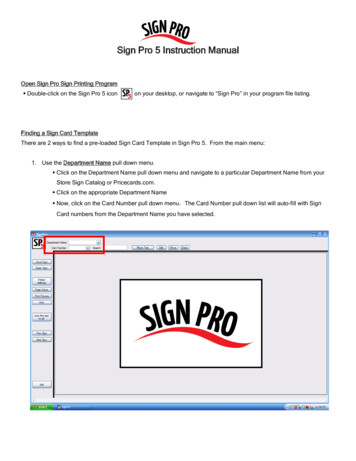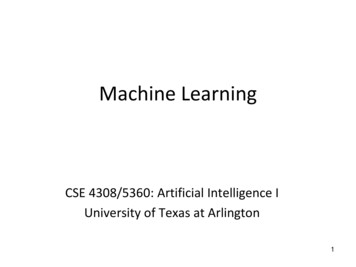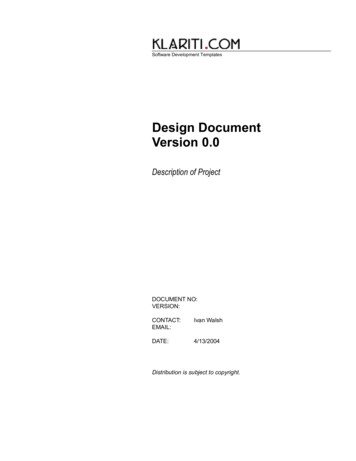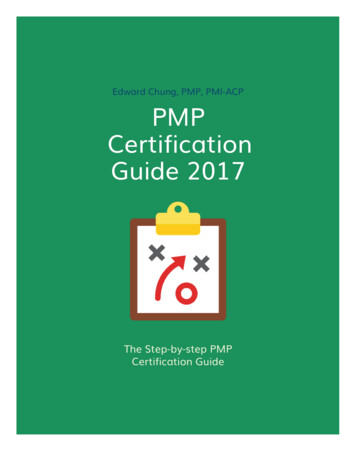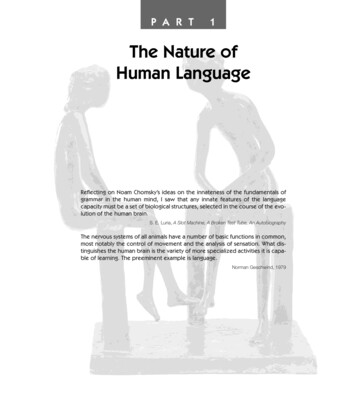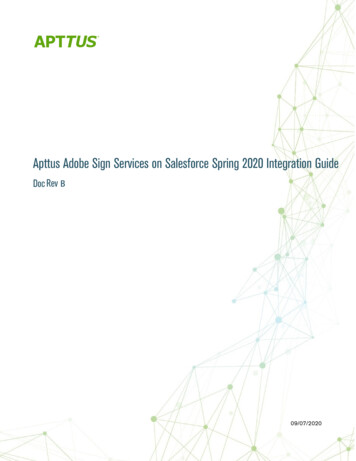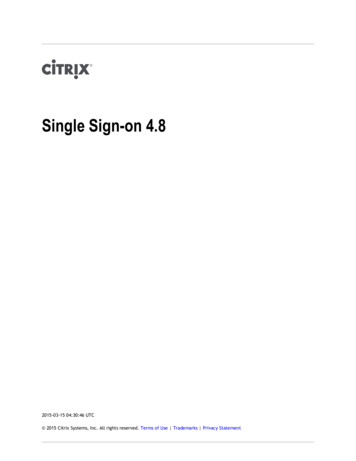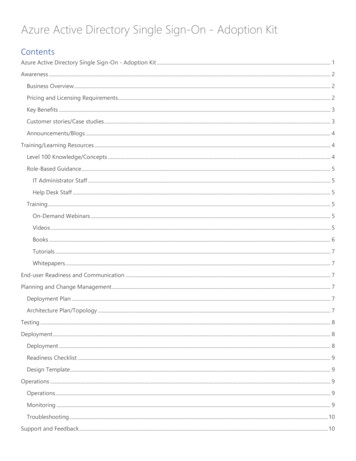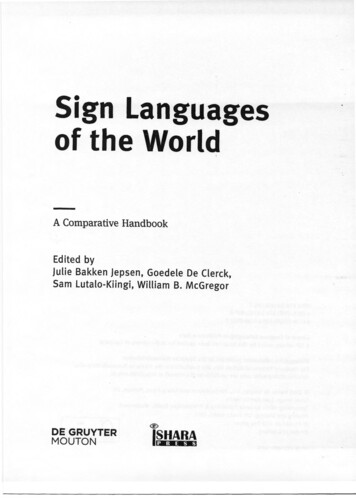
Transcription
Sign Languagesof the WorldA Comparative HandbookEdited byJulie Bakken Jepsen, Goedele De Clerck,Sam Lutalo-Kiingi, William B. McGregorDE GRUYTERMOUTON IS HARAP R E S S
ISBN 978-1-61451-796-2e-ISBN (PDF) 978 -1-61451-817-4e-ISBN (EPUB) 978-1-5015 -0102-9Library of Congress Cataloging-in-Publication DataA CIP catalog record for this book has been applied for at the Library of Congress.Bibliographic information published by the Deutsche NationalbibliothekThe Deutsche Nationalbibliothe k lists this publication in the Deutsche Nationalbibliografie;detailed bibliographic data are available on the Internet at http://dnb.dnb.de. 2015 Walter de Gruyter, Inc., Berlin/Boston and lshara Press, Preston, UKCover image: Juan Ramon Vali fioTypesetting: Meta Systems Publishing & Printservices GmbH , WustermarkPrinting and binding: CPI books GmbH, Leck Printed on acid-free paperMIXPrinted in GermanyFSCWMl! . fsc .O Owww.degruyter.comPopier llus vernntwortungsvollen QuellenFSC'" C083411
James Tai and Jane Tsay32 Taiwan Sign Language1 Basic facts about Taiwan Sign LanguageLanguage name: Taiwan shouyu (in Chinese); Taiwan Sign Language (in English)Alternative names: Taiwan ziran shouyu 'Taiwan natural sign language'Location: Taiwan, Republic of ChinaVarieties: Northern dialect and southern dialect. Both are included in the TaiwanSign Language Online Dictionary.Number of signers: 30,000-60,0002 Origin and histo ryTaiwan Sign Language (hereafter, TSL) here refers to the native language developed and used by the deaf in Taiwan. Smith (2005) reported that it was used byapproximately 30,000 deaf persons residing in Taiwan, but did not mention howthis estimation was obtained. According to the 2012 report of the Ministry of theInterior, Taiwan, there were about 122,285 citizens with Hearing Mechanism Disability in Taiwan. However, the report did not include information about how manyof these citizens with hearing disability used TSL for communication. 1The history of TSL can be dated back to when the first school for the deaf wasestablished in 1915 by the Japanese during the period of Japanese occupation ofTaiwan (1895-1945). Little is known about what kind of sign language had existedin Taiwan prior to the Japanese occupation. Korea was also occupied by Japan during 1910-1945. Therefore, TSL as well as Korean Sign Language are historically related to Japanese Sign Language (JSL). Even today, ISL still shares high degree ofmutual intelligibility between the lexicons of TSL, JSL, and KSL (Su and Tai 2009).1 There has not been any official survey of the number of ISL signers. According to the formerpresident of the National Association of the Deaf in the Republic of China, Mr. Yushan GU (personalcommunication), there are approximately 60,000 signers of ISL.James Tai, National Chung Cheng University, e-mail: Lngtai@ccu.edu.twJane Tsay, National Chung Cheng University, e-mail: Lngtsay@ccu.edu.tw
772 -James Tai and Jane TsayDuring the Japanese occupation of Taiwan, soon after the first deaf school wasestablished in Tainan (in southern Taiwan) in 1915, another deaf school was founded in Taipei (in northern Taiwan) in 1917. The first group of Japanese teachers atTainan Deaf School came from the Osaka area in Japan, while the first group ofJapanese teachers at Taipei Deaf School came from the Tokyo area. The dialectaldifferences of JSL in these two areas thus contributed to the initial differences between the southern dialect and the northern dialect of TSL, indicated by S andN, respectively, in the examples. These two TSL dialects are mutually intelligible.The grammatical structures for these two dialects are basically the same. The differences between these two dialects are primarily lexical. For example, the wordsFIVE, TEN, CAR, WINE, VEGETABLE, GREEN-ONION and PINEAPPLE are signeddifferently in these two dialects of TSL.After World War II, in 1945, Taiwan was turned over to the Republic of China.The Japanese teachers at both schools for the deaf in Taiwan were sent back toJapan. The Taiwanese teachers at both schools continued to teach the studentswith JSL. In 1949, the Communist Party came to power in China, resulting in a largeimmigration of more than two million Chinese from Mainland China to Taiwan.Some deaf people and several former teachers at the Nanjing and Shanghai schoolsfor the deaf in China also came to Taiwan and brought with them Chinese SignLanguage (CSL), known as zhongguo shouyu 'China sign language' in Mandarin.Therefore, some signs from CSL may also have been introduced into TSL. 2Also, after 1945, Mandarin Chinese replaced Japanese as the official languagefor education, administration, and mass media in Taiwan. Consequently, SignedChinese, an artificial sign language created mainly by the educators based on theambient spoken language Mandarin, became the instruction language at the deafschools. Although Signed Chinese is very different from TSL in morphology andsyntax, it has borrowed a large number of lexical items from TSL. In Taiwan, TSLis known as ziran shouyu 'natural sign language', while Signed Chinese refers tothe signed Mandarin Chinese known as wenfa shouyu 'grammatical sign language'.3 Bilingualism and language contact3.1 EducationNowadays, there are three public deaf schools located in northern, central andsouthern Taiwan. Since early 1970s, the Total Communication approach has beenadopted for school instruction. Spoken Mandarin Chinese, Signed Chinese, and2 For a more detailed description of the history of deaf education in Taiwan during 1945 and 1949,see Smith (2005).
Taiwan Sign Language-773written Chinese have all been used in classroom instruction, while Deaf studentscontinue to use TSL to communicate with each other. Thus, in the three deafschools, students are in contact with Mandarin Chinese, written as well as spoken,in addition to Signed Chinese and TSL. This kind of language situation has contributed to the change of TSL in the last century in both lexicon and syntax. Whendeaf children are enrolled in ordinary schools, they are drilled to have the oralcommunication skill in Mandarin Chinese. It is not unusual that they learn TSL asgrown-ups to communicate with deaf signers of TSL. Deaf signers of TSL sometimesalso use Signed Chinese to communicate with others, especially when encountering professional and technical terms.3.2 StandardizationIn the mid-1970s, the Ministry of Education formed a work group of representativesof the three deaf schools to standardize and unify the signs to be used for instructional purposes in Taiwan. They determined a basic vocabulary of approximately1750 signs and also invented signs for words and concepts often used in teaching.This collection of signs, widely adopted from Signed Chinese, Shouyu Huace (Li1978), was accepted with great enthusiasm by the educators. However, becausevery few deaf people were even marginally involved in the work preparation, theDeaf community was disappointed and felt that the work failed to reflect theirviews as to how signs should be presented (Smith 2005). In the subsequent editionsof this work (Ministry of Education 1987, Ministry of Education, Special EducationWork Group 2000a, 2000b), more deaf signers were involved.While the educators in deaf schools prefer using the "standardized" signswhich are mostly based on Signed Chinese, TSL signers continue to use and consider the original signs as more "natural'', except for technical terms or modern inventions. In the TSL Online Dictionary to be introduced in this chapter, ali variationsof signs are included without any intention of standardizing the language.3.3 Influence from dominant languagesIn Taiwan, Mandarin Chinese is the official and most dominant spoken language.Its immediate influence shows in the prevailing use of Signed Chinese in the deafeducation system. Although Signed Chinese is based on the grammar of MandarinChinese, thus called wenfa shouyu 'grammatical sign language', it shares a largenumber of lexical items with TSL.TSL and Signed Chinese in Taiwan are mutually intelligible mainly at the levelof the shared vocabulary and frozen phrases. In actual discourse, the mutual intelligibility might be reduced due to the differences in grammatical structures.
l774 -James Tai and Jane TsayIn addition to Mandarin, deaf and hard-hearing persons are also exposed totwo other Sinitic languages, Southern Min (;;i.lso called Taiwanese) and Hakka. Theinfluence of these two spoken languages has not been reported.Chinese is used in all printed materials such as documents, books, and newspapers. When specific Chinese characters are being referred to, they are either written out on paper or traced the character with the index finger on the palm of theweak hand (Smith 1989). Character signs based the Chinese orthography are commonly used in ISL (see Section 6.1).4 Political and social context4.1 OrganizationsThere are mainly two organizations of the deaf in Taiwan, i.e. National Associationof the Deaf in the Republic of China http://www.nad.org.tw/ap/index.aspx and Chinese Deaf Association http://www.deaf.org.tw/.The National Association of the Deaf in the Republic of China was establishedin 1992 to promote academic research of Deaf culture and the improvement of thewelfare for the hearing-impaired. It also aims to assist the government in planningfor a barrier-free environment for hearing-impaired people. They also provide employment and psychological counseling for the deaf.The Chinese Deaf Association was established in 1995 by a group of enthusiastic deaf people to develop a barrier-free environment for the Taiwanese hearingimpaired and to establish an Overseas Study Guidance Center for the Hearing-impaired. They also established the Employment Library Center and the EmploymentGuidance Center for the Hearing-impaired to further guarantee the rights and welfare of the deaf people.4.2 State of the languageDue to the policy of "mainstream" education, the majority of deaf and hard-hearingstudents are trained to orally use Mandarin Chinese as their main communicationtool. This policy is preferred by the parents of deaf children and endorsed by theexperts in the field of special education. Therefore, deaf and hard-hearing childrenare encouraged to enroll in schools for the hearing children to receive the samecurriculum as hearing students. As a result, the number of deaf children enrolledin the three public deaf schools has been shrinking and these three schools havebeen forced to enroll other ldnds of students with special needs (e.g., handicapped,autism, mentally retarded) to prevent the schools from closing.
Taiwan Sign Language-775The official governmental policy requires TSL interpreters in courts and civicservices for deaf persons, as well as in national broadcastings of important news.However, the majority of the parents and speech therapists prefer deaf and hardhearing children to be able to have the oral skill of communication.4.3 Language maintenance effortsIn the United States, ASL seems to be accepted as a real language by the generalpublic, and many universities accept ASL courses to fulfill foreign language requirements. Also generally understood in the U.S. is the notion that culture andlanguage exit together and Deaf culture is perceived by many as a natural part ofAmerican multiculturalism. In contrast, the Deaf culture of TSL is not appreciatedas such. Parents of deaf children prefer to enroll their children in schools for hearing children. Even if they have to enroll their deaf children in deaf schools, theyput pressure on deaf schools not to teach TSL. However, some local educators,psychologists, and linguists have expressed their concern that this may not be thewisest policy in the long run. More importantly, the Deaf themselves are teachingTSL, publishing TSL textbooks, and participating in research projects of TSL aswell as in international forums on sign language and deaf education. Thus, againstthe lack of general appreciation of Deaf culture in the society, there are positivesigns for the acceptance of TSL in deaf community and educational circles.5 The structure of signsRegarding distinctive features of signs, we introduce handshape, place of articulation, movement, orientation, and non-manual features.5.1 HandshapeTSL has 62 distinctive handshapes based on previous studies and our collection ofTSL signs (cf. Smith and Ting 1979, 1984; Lee 2003; Chang, Su, and Tai 2005). 3 SeeAppendix I for the list of handshapes in TSL.5.2 Place of articulationPLEASE vs. BE is a minimal pair that contrasts in location. They both use the handshape B (la), with the palm parallel to the center plane of the body. The index3 Handshape names adopt the American Sign Language handshape names in English alphabetand numbers with necessary variations. See Appendix I for more details.
776 -James Tai and Jane Tsayfinger of the hand in PLEASE makes contact on the forehead (lb), while in BE, theIcontact is at the chin (le). 4 See Appendix II for TSL notation conventions.(1) Phonemic contrast in location: PLEASE vs. BE(a) Handshape B(b) PLEASE(c) BE5.3 MovementMALE vs. THANK is a minimal pair that contrasts in local movement. Both signsuse the handshape Open A (2a), but in MALE the hand rotates back and forth atthe wrist (2b), while in THANK the thumb repeatedly bends (2c).(2) Contrast in local movement: MALE vs. THANK(a) Handshape Open A(b) MALE(c) THANK5.4 OrientationNOW vs. CALM-DOWN is a minimal pair that contrasts in hand orientation. Theyboth use the handshape Open B (3a) on both hands, and both start with the handspalm-downward and involve downward movements, but in NOW, the fingertips ofboth hands point forward away from the body (3b), while in CALM-DOWN theypoint towards each other (3c).4 Pictures in this paper are from the TSL Database of the Sign Language Research Group at theNational Chung Cheng University, Taiwan, unless otherwise noted. The demonstrator is Mr. YushanGu.
Taiwan Sign Language-777(3) Contrast in hand orientation: NOW vs. CALM-DOWN(a) Open B(b) NOW(c) CALM-DOWN5.5 Non-manual featuresHEAD vs. UNDERSTAND is a minimal pair that contrasts in non-manual features.They both involve the handshape 1 (4a), with the index tip contacting the temple,but in HEAD no facial expression is made (4b), while in UNDERSTAND, the mouthis rounded and sucks in air, and the head moves backward at the same time (4c).(4) Contrast in nonmanual features: HEAD vs. UNDERSTAND(a) Handshape 1(b) HEAD(c) UNDERSTAND
778 -James Tai and Jane Tsay6 Associated sign systems6.1 Character signsCharacter signs based on the Chinese writing system are commonly used alongwith fingerspelling based on English alphabet. The following methods of constructing character signs in TSL have been identified by Ann (1998).1. To imitate the shape of either the whole or a part of a Chinese character bymeans of handshape: .:E, E82. To trace either the whole or a part of a Chinese character in the air: f, ffJt3. To combine both (1) and (2) methods: T, :t4. To use both handshape and the mouth: , 5. To combine a natural sign with tracing: *.Loan translations from Chinese coinages are also adopted for new things. For example, 'high speed railway', in addition to the mimic sign of the shape of the engine, can also be signed with TSL sign for 'high' compounded with sign for 'iron',a loan translation from the Chinese term m 'high iron'. Blending of TSL signsand character signs are also adopted to describe new things. For instance, 'cancer'is signed with TSL sign for the sickness plus character sign for . pattern after theChinese character . which consists of a radical for sickness and a componentcharacter for dfi. In short, TSL can always find ways to express new things.6.2 Fingerspelling and initializationFingerspelling and initialization based on English alphabet are adopted in TSL. Forinstance, M stands for McDonald because of its logo. English proper names suchas Chomsky, and abbreviations, such as MSN and AED, are spelled out in ASLEnglish alphabet. Examples of initialization would be F for 'fruit' and B for 'beer'.7 Basic morphology and lexicon7.1 Noun morphology: Compounding7.1.1 Serial compoundingCompounding differs from affixation in that more than one root morpheme is involved. There are many examples of serial compounds in TSL, which are distinguished from phrases by the order of the morphemes (sometimes reverse of thatfound in phrases), semantic opacity, and phonological simplification. Below weillustrate the first two of these diagnostics (originally established for ASL by Liddelland Johnson 1986; see also Smith 1982).
Taiwan Sign Language-779Noun phrases in TSL usually have the order [noun"modifier]. So the [modifier"noun] or [noun"noun] structure suggests compounding. Examples in 5 illustrate non-phrasal morpheme order.(5) Serial compounds: [modifier"noun] or [noun"noun](a) APPLERED"FRUIT(b) JUDGE LAW"MALLET(c) PERSONALITY PERSON"HABBITCOFFIN"CAR(d) HEARSEExamples in 6 illustrate semantic opacity.(6) Serial compounds: semantic opacity(a) COFFEEBROWN"STIRTIME"ONE(b) ONE-O'CLOCK(c) DEFICITRED"HIGH-LEVELWHITE"FLAG(d) SURRENDERSome serial compounds seem to follow templates. For example, [X"PLACE] is aproductive compounding template, as shown in the Example 7.(7) Serial compounds with(a) TRAIN-STATION(b) COURT(c) POLICE-OFFICEtemplate [X"PLACE]TRAIN"PLACELAW"PLACEPOLICE"PLACE7.1.2 Parallel compoundingIn MARRY, one hand with the sign MALE and the other hand with the sign FEMALEmove simultaneously to meet each other in front of the chest (8), while in DIVORCE, the hand with the sign MALE and the other hand with the sign FEMALEmove simultaneously apart from each other (9).(8) MARRY MALEuFEMALE - together (hands moving to meet each other)
780 -James Tai and Jane Tsay(9) DIVORCE MALEuFEMALE - separate (hands moving away from each other)Interestingly, parallel compounds may be contained within serial compounds,while the reverse is apparently impossible. This is consistent with phonologicalarguments (given below) that different compound types may be "ordered differently" in a lexical phonology analysis (or in equivalent constraint-based analyses). InWIFE and HUSBAND, MARRY (a parallel compound with MALEuFEMALE) is signedfollowed by FEMALE and MALE in the Example 10 and 11 respectively.(10) WIFE MARRY (MALEuFEMALE)" FEMALE(a) MARRY(b) FEMALE(11) HUSBAND MARRY (MALEuFEMALE) " MALE(a) MARRY(b) MALE
Taiwan Sign Language-7817 .2 Verb morphology: agreement and aspect marking7 .2.1 Verb inflectionThe classic work on TSL verb inflection is Smith (1989). Verb inflections in TSLinclude agreement and aspect markers, but apparently not tense markers.Agreement includes subject-object agreement (usually simultaneous/non-concatenative), verb-subject agreement (using predicate classifier), gender agreement,and number agreement. Aspect marking includes perfective, progressive, and durational aspect which indicates prolonged status and/or intensity and frequency.7 .2.2 AgreementHere are some general observations about agreement in TSL. First of all, agreementshowing a grammatical relation is marked by non-concatenative morphology, specifically by moving the hand away from the subject and/or towards the object. Thisappears to be a sign language universal (Aronoff, Meir and Sandler 2000) leadingsome to question whether this should be understood as grammatical agreement atall, rather than an iconic representation of relations between entities in some mental space (e.g., Liddell 2003).In the following Example 12 'The dog bit the cat,' the verb BITE moves fromthe agent DOG (co-indexed with j) towards the patient CAT (co-indexed with i).(Note that the patient CAT is signed first, possibly due to topicalization or a topic comment structure).(12)(a) CATi(b) DOGi'The dog bit the cat.'(c)BITEi i·Secondly, some verbs also show agreement with the subject via the use of (predicate) classifiers (though again Liddell 2003 and Chang, Su, and Tai 2005 disagreewith this analysis).In the following Example 13 'The dog entered the house', HOUSEi is mentionedfirst (13a). Then the subject DOGi is signed in full form in (13b), but in the form ofan animal classifier DOGpro being inflected on the verb ENTERi l as in (13c) (this
782 -James Tai and Jane Tsayldnd of predicate classifier is considered a "proform (pro)" in Chang, Su, and Tai2005).(13)(a) HOUSEi(b) DOGi(c) HOUSEpro DOGpro-ENTERi i·'The dog entered the house.'Thirdly, there also appears to be agreement with gender and number features. Gender agreement (if used) is also indicated by predicate classifiers. In the followingExample 'Tell her,' the third person singular pronoun, indicated by the left position, is marked with the female classifier, the pinky. (Note that the default form ofthe sign TELL uses the thumb. See Example TELL (one female person) (14)).(14)WOMAN pro TELL.'Tell her.'Agreement verbs will be introduced below in the section of Basic Syntax.7.2.3 Aspect markingRegarding aspect marking, TSL marks perfective aspect on verbs of motion by holding the final position at the end of the verb, similar to what Sandler (1993) observedfor ASL. In the following Example 15, there is a hold at the end of the sentencemarldng the termination of the action.
Taiwan Sign Language-783(15)(a) HOUSEi(b) DOGi(c) HOUSEpro DOGpro-ENTER[holctJ·'The dog ran (has run) into the room.A more common way of expressing perfective is adding a morpheme FINISHEDafter the verb.(16)(a) HEi(c) FINISH.'He has come (arrived).'(b) COME
784 -James Tai and Jane TsayIntensity and frequency are often marked by reduplication. For example, inthe examples in (17), the reduplication does not only indicate the repetition (i.e.frequency), it has a connotation of getting more annoying (intensity).(17) Intensity and frequency marked by reduplication(a) ASK-ASK-ASK'keep asking'(b) TELL-TELL-TELL'keep telling'(c) 5COLD-SCOLD-SCOLD 'keep scolding'Reduplication with a simultaneous raise of the hand(s) also indicates the increaseof degree or intensity in either quality or quantity. For example, ADD is signed withthe side of one fist (facing outward) touching the side of the other fist (facinginward) in (18). When the movement in ADD is reduplicated together with the reduplicated raise of the two hands, it means 'keep increasing', as in Example (19).(18)ADD(19) Intensity and frequency marked by reduplication'keep increasing'(a) ADD (reduplication raising the hands)(b) QUARREL (reduplication raising the hands) 'keep quarreling (gettingmore and more serious)''keep arguing (getting(c) ARGUE (reduplication raising the hands)more and more serious)'Raising hands in these examples naturally accompany reduplication.7 .3 ClassifiersClassifier constructions refer to complex predicates that express motion, position,stative-descriptive information, and handling information (Emmorey 2002).Classifiers in TSL are all drawn from the list of basic handshapes shown inAppendix I. TSL classifiers can be categorized based on a small set of physical andsemantic features underlying lexicon and syntax of human languages followingPinker (1989), including whole entity classifiers (for animate entities, inanimate
Taiwan Sign Language-785entities, instrument), limb classifiers, part classifiers, handling classifiers, and extension/surface classifiers. See Appendix III for the list of classifiers for each category.8 Basic syntax8.1 Three types of verbs and word orderAs in other sign languages, verbs in TSL can be classified into plain verbs, agreement verbs, and spatial verbs. Plain verbs do not move through sign space to showgrammatical relations. They use SVO word order to indicate subject-object grammatical relation, although OSV and SOV orders are also very common due to topicalization of the object. Agreement verbs indicate the subject-object grammaticalrelationship by moving through sign space. Spatial verbs convey the informationabout movement and location of an object in real world. The moved objects maybe the subject or the object. In essence, agreement verbs move in syntactic space,while spatial verbs move in topographic space (Sutton-Spence and Woll 1999). Theword order of agreement verbs is usually OSV, but SOV is also acceptable. As forthe spatial verbs, the location of a referent (or an object) is usually signed firstfollowed by the referent and the spatial verb.In the section below, we briefly illustrate the three types of verbs, showingtheir word orders and the classifiers used in classifier predicates vs. spatial verbs.8.1.1 Plain verbsWords such as LIKE, REMEMBER, BE-FAMILIAR-WITH, THINK, FEAR, amongothers are plain verbs in TSL. They show relatively little modification and do notmove through space to show grammatical information. Manner and aspect aremarked in plain verbs by different speed of repetition of the verb and presence ofnon-manual features. For example, to express the idea of doing something for along time, the movement of the verb sign is typically lengthened. To indicate intensity, the verb sign is normally shortened and made with tense, retracted movements (Smith 1989: 82-83).Because plain verbs are frequently made using the body as the location, theyare sometimes known as "body-anchored" verbs (Sutton-Spence and Woll 1999).As they are "body-anchored", they do not move through space to indicate the subject-object grammatical relation or to give information about person and numberof the subject and object. For example, to sign the verb LIKE, the tips of the indexfinger and the thumb contact the facial location, as shown in (20c).
786 -James Tai and Jane TsaySince plain verbs cannot move through space to show the information of grammatical relations, the subject (i.e. BROTHER) and the object (i.e. DOG) do notchange the movement and orientation of the verb, as shown in (20). However, topicalization of the object is also more frequently used in discourse.(20)(a) DOG(b) BROTHER'(My) brother likes dogs.'(c) LIKE.8.1.2 Agreement verbsExamples of agreement verbs in ISL are BELIEVE, TELL, GIVE, ASK, SEE, PAY,ANSWER, and many others. Agreement verbs move through space to indicate thesubject-object grammatical relationship, thus also allowing the inclusion of information about person and number of the subject and object. This is accomplishedby moving the verb in syntactic space. That is, information about who is carryingout the action, and who or what is affected by the action is shown by changes inmovement and orientation of the verb.Unlike plain verbs, agreement verbs change their forms in accordance with thesubject or object of the sentence. The different forms that these verbs assume reflect different combinations of subjects and objects. Take the sentences in (21) and(22) for example, the agreement verb BELIEVE moves toward the position wherethe object is located. In (21) the verb moves toward the object position, i.e. MOTHER, whereas in (22) the signer is the object; therefore, the verb moves toward thesigner himself.(21)(a) MOTHER(b) MOTHERpro FATHER'(My) father believes (my) mother.'(c) BELIEVE-MOTHER.
Taiwan Sign Language-787(22)(a) FATHER(b) BELIEVE-ME.'(My) father believes me.'It should be pointed out that in an agreement verb, there is a start point (subjectagreement marker), a path movement (verb stem), and then an end point (objectagreement marker). In general, the starting point of these verbs is the location ofthe subject, while the end point is where the object is. However, the agreementverbs such as INVITE, TAKE-FROM, BORROW, etc. are exceptions to this generalization. These verbs show "backwards agreement" where the start point marks theobject and the end point marks the subject.8.1.3 Spatial verbsSpatial verbs use topographic space, not syntactic space. Spatial verbs in ISL include RUN, JUMP, WALK-TO, and many others. These verbs are referred to as "verbsof motion and location" (Supalla 1982) or "spatial-locative predicates" (Smith1989). In TSL, the sentence with a spatial verb such as RUN-ABOUT and a classifiermorpheme is shown in (23), in which a handshape for a class of objects (i.e. ANI MAL, see 23c) is used to indicate a group of referents such as dogs, cats, frogs ,bees, birds, scorpion, and the like. Such a handshape is a bound morpheme andcannot be used in isolation.(23)(a) ROOM(b) DOG'The dog is running about in the room.'(c) ROOMpro ANIMALRUN-ABOUT.
788 -James Tai and Jane TsayAs shown above, the predicate RUN ABOUT contains information about the movement of the subject, and the classifier handshape ANIMAL is used for any animalswith similar features. It is observed that the full sign (e.g., the DOG) is normallyproduced first, followed by the classifier morpheme (e.g., ANIMAL). The full signis usually needed to identify the referent; otherwise, it is impossible to identifywhat the referent really is. As analyzed by Supalla (1982), spatial predicates havetwo parts - a movement morpheme and a classifier handshape morpheme.In addition, spatial verbs may inflect to show manner and aspect, but they donot inflect for person or number. They can give information about the path, trajectory and speed of movement of the action described by the verb, and about thelocation of the action (Chang, Su and Tai 2005).8.2 Auxiliaries and word orderOne of the most interesting issues in sign language syntax is the general absenceof auxiliaries in sign languages. TSL is the first sign language which has beendemonstrated to have auxiliaries. Smith (1989, 1990) has identified three auxiliariesin TSL. They are Aux-1, Aux-2, and Aux-II. They are shown in (24).(24)Aux-1Aux-2Aux-IIAccording to Smith (1990: 216-217), "These signs have all the morphological properties of agreement verbs. They move from subject to object loci." Their primary function is to convey the subject-object relationship. They occur before the main verband carry the subject-object agreement f
Taiwan (1895-1945). Little is known about what kind of sign language had existed in Taiwan prior to the Japanese occupation. Korea was also occupied by Japan dur ing 1910-1945. Therefore, TSL as well as Korean Sign Language are historically relat ed to Japanese Sign Language
